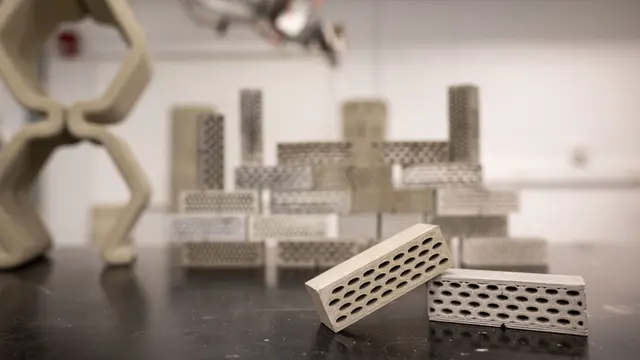Researchers at Princeton University have unveiled an innovative cement paste that is 5.6 times stronger than traditional cement, mortar, and other cement-based materials. This innovative paste is modelled after the structure of human cortical bone, specifically the tubular architecture found in the femur (thigh bone). By adopting this design, the new cement paste enhances resistance to crack propagation and improves its ability to deform without catastrophic failure, marking a significant advancement in construction material technology.
The Need for Tougher Construction Materials
Cement-based materials have been an essential part of the construction industry due to their strength and versatility. However, they often suffer from brittleness, which can lead to sudden structural failures. Such failures pose serious risks to both property and human lives. Shashank Gupta, lead researcher and PhD candidate at Princeton, highlights the importance of developing materials that can withstand cracking and effectively distribute impact forces throughout a structure. In traditional construction, a building made with materials that lack toughness can collapse abruptly, resulting in significant consequences.
The demand for tougher materials is driven by the need for safety and reliability. As urban areas expand, the construction industry must develop materials that:
- Bear Heavy Loads: Structures need to support significant weight and withstand various stresses.
- Exhibit Resilience: Materials should resist damage over time, ensuring safety and longevity.
This new cement paste addresses these weaknesses, enhancing the toughness and reliability of future construction projects.

The Science Behind the Innovation
To develop this innovative cement paste, researchers examined natural materials known for their strength and toughness. Their investigation led them to human cortical bone, which excels at resisting fractures. The structure of cortical bone consists of:
- Elliptical Tubular Components: Known as osteons, these units are embedded in an organic matrix.
- Unique Architecture: This design allows the bone to effectively distribute loads and resist damage, making it an ideal model for new materials.
Inspired by this structure, the researchers created a cement paste that features cylindrical and elliptical tubes. These tubes play a critical role in the material’s performance:
- Crack Resistance: When a crack forms in the cement, it becomes trapped by the surrounding tubes, effectively delaying its spread. This is crucial for maintaining the integrity of the material.
- Energy Absorption: The surrounding tubes absorb energy that would otherwise contribute to the rapid growth of the crack. By dissipating this energy, the cement gains valuable time to resist further damage.
The mechanism by which the cement paste operates is particularly noteworthy. Each time a crack attempts to extend, the tubular structures help control its propagation, which helps prevent sudden and catastrophic failures. Instead of the material breaking all at once, it can withstand progressive damage, making it significantly tougher and more reliable than traditional options. This innovative design not only enhances the material’s strength but also its overall durability, paving the way for safer construction practices.
Reinforcing Cement Through Geometry
Traditionally, cement has been reinforced with various materials such as plastics, fibers, and other additives to improve toughness. However, this innovative approach emphasizes the role of geometry rather than relying solely on external reinforcements:
- Focus on Geometry: By optimizing the size, shape, and orientation of the tubular structures within the cement paste, researchers discovered a way to enhance crack resistance without sacrificing other essential properties.
- Unexpected Results: One might think that adding hollow tubes would make the material weaker, but the research shows the opposite. Instead, the tubes help improve how cracks interact with the cement, boosting its overall strength and performance.
This approach could reshape material engineering, setting a new standard for developing tougher, more resilient building materials that have the potential to transform the industry.
Practical Applications and Future Directions
The potential applications of this bio-inspired cement paste are vast. Its ability to replace conventional materials could lead to significant improvements in the safety and longevity of buildings, bridges, and other structures. The potential applications of this bio-inspired cement paste are vast and can lead to significant improvements in the safety and longevity of various structures:
- Buildings: Enhanced strength and crack resistance make it suitable for high-rise structures and residential buildings.
- Bridges: The increased durability can improve the lifespan and safety of critical infrastructure.
- Roads and Highways: This cement could provide enhanced resilience in pavements, reducing maintenance costs and improving safety.
Looking ahead, Gupta emphasizes that the research team has only begun to explore the possibilities offered by this new material. The principles underlying the tubular design and crack-resistant properties could be applied to a variety of other brittle materials, potentially transforming the construction industry. By expanding the scope of this research, the team aims to develop more damage-resistant structures across various sectors.
Additionally, the researchers have developed a framework to assess the degree of disorder within the cement paste. Understanding these irregularities is crucial for:
- Scaling Production: Ensuring consistent quality in larger applications and allowing for widespread adoption in the construction industry.
- Optimizing Configurations: Helping engineers and architects determine the best designs and configurations for specific applications, further enhancing the utility of the material.
Conclusion
The development of bio-inspired cement paste represents a leap forward for construction materials. By mimicking the natural strength and toughness of cortical bone, researchers have created a cement paste that not only outperforms traditional options but also addresses the pressing need for safer building materials. As this innovative material matures, it holds the promise of enhancing building safety and sustainability in an industry increasingly reliant on tougher, more resilient materials.
Image Source: interestingengineering.com, inspenet.com,


